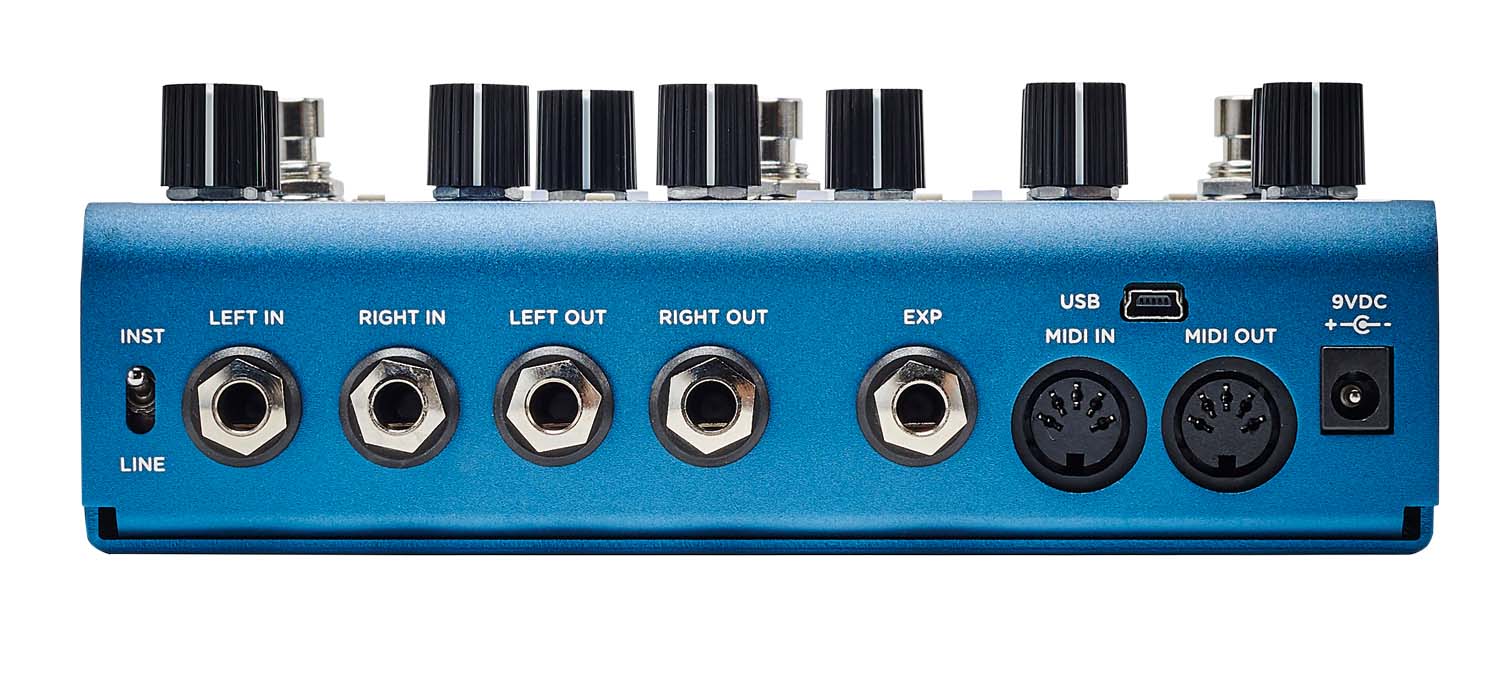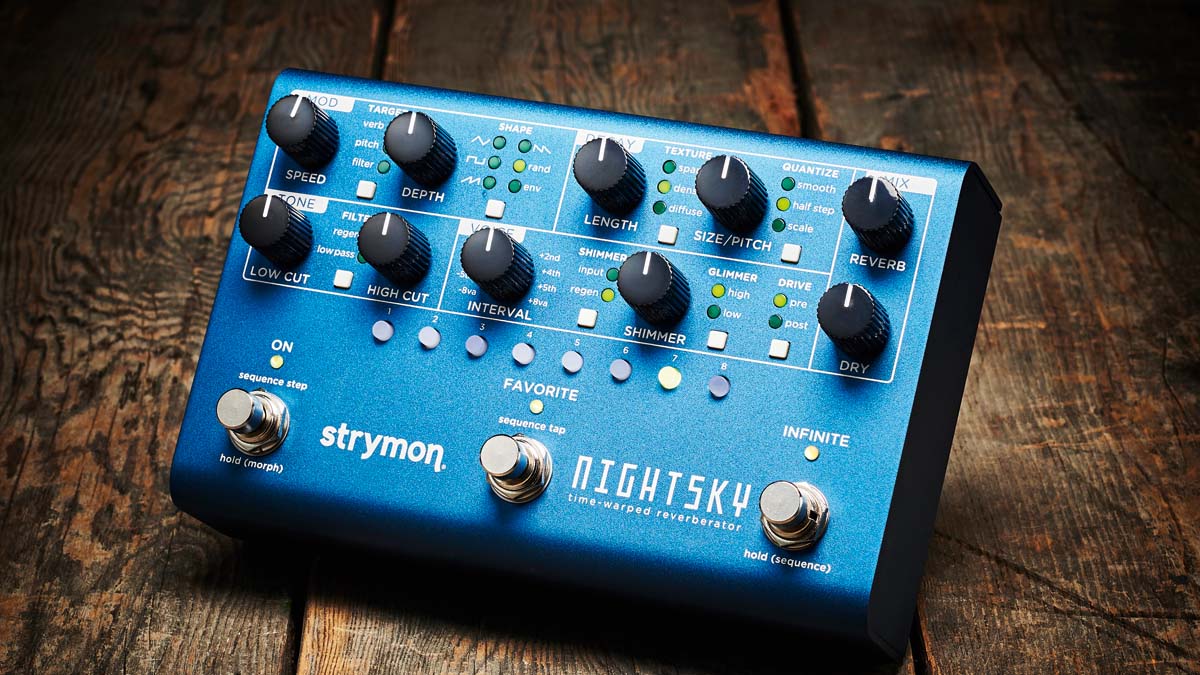MusicRadar Verdict
The NightSky might bit too out there for some players, but it rewards the adventurous with immersive cinematic sounds. For transformative reverb and a bewildering cosmos of ambience, there is no greater pedal.
Pros
- +
Unbeatable sounds.
- +
Heaps of features in a user-friendly layout.
- +
Lots of presets.
- +
Secondary footswitch functions make for fun performances.
- +
Infinite freeze is super cool.
Cons
- -
Nothing, but it is a reverb specialist's workstation.
MusicRadar's got your back
What is it?
You could argue that Strymon has already built the ultimate reverb pedal in the form of the BigSky, but some occasions and many players are looking for something more off-the-wall when it comes to electric guitar ambience. That's where the NightSky comes in.
Indeed, Strymon doesn't even call it a reverb pedal. That's too vanilla. The Californian company describes it as a “Time-Warped Reverberator”, and they give players real-time control over any number of the many reverb parameters here.
As with the BigSky, the NightSky has a dizzying array of features. At first blush, there seem to be enough controls to land a jet airliner. But logic rules the day here. While it might take you months spent through the looking glass to truly fathom the depths of this unit, getting started is a breeze, and the presets are as good a place as any to begin.
While there are some secondary functions on some controls – such as pre-delay, which is accessed by pressing and holding the Texture button while turning the Reverb knob, left for shorter pre-delays, right for longer – the demarcated sections dispense with any need for a menu screen.
If you want to change something, there is a section for that, no back and forth hunting for a sound. There is a Mod section that allows you to take verb, pitch or filter, pick a waveshape or the envelope follower, and then adjust the rate, speed and depth. The Decay section allows you to cycle through Sparse, Dense or Diffuse reverbs via the Texture button and then adjust the size and length of the decay.

Once you have found something cool, simply save it down as a preset. You can access 16 presets via the eight Sequence/Preset buttons. These light green from 1-8, and amber from 9 to 16. On a darkened stage (or, to really get into it, under a canopy of stars) these LEDs are nice and bright and let you know what's going on.
Navigating back and forth between presets and the current settings of the pedal is performed via the Favorite footswitch. The build is top-quality, with the enclosure a similar size to Strymon's other top-line pedals – the Volante, BigSky, TimeLine etc.
Of course, this being Strymon, and this being a state-of-the-art digital unit, you can access some 300 presets via MIDI. While we are reviewing the NightSky from the perspective of a guitar player, bear in mind that it is similarly designed to work with synths, which opens up another can of wormholes when it comes to outré sounds.
Performance and verdict
To build a sound from scratch, choose your reverb texture. Sparse offers a sort delay effect when you play staccato, and cleans up nicely with sustained playing . Dense is akin to plate reverb – though it gets hectic at high delay times. Diffuse is for more expansive ambient adventures.
Simply set the decay length via a knob, and then you are read for some more bespoke twists. The Size/Pitch knob changes the virtual size of reverb's space and the pitch.
The pitch shifting on the decay is exceptional and you can take it from a perfectly quantised setting that varies smoothly and continuously over a 2.5 octave pitch range, is quantised into half-step intervals over a two octave range, or you can enter a scale mode that quantises the reverb into scales. In scale mode you have a two-octave range and eight scales to choose from, including major and minor pentatonics, dorian and diminished scales.
You have low-cut and high-cut filters on-hand to sculpt the reverb's EQ, and the Mod section is comprehensive.
The Shimmer reverb is exceptional. It's different too. Here the Shimmer can be set to a certain musical interval and applied to the input of the reverb core, or for a more sustained effect it can be used on the reverb's core itself. The Glimmer function is switchable and gives the reverb tail's harmonic content a little more more magic– you can use it to add intrigue at either end of the frequency spectrum depending on how bright/dark you want the reverb.
• Strymon BigSky
This kind of quality doesn't come cheap, but reverbs don't get much better than this - a superlative stompbox in every way.
• Eventide Blackhole
As those who own a Space or H9 will tell you, the Blackhole reverb sound is not of this Earth. To have it in a standalone pedal, with knobs to turn plus programmable presets, will have today's seekers of soundscapes all starry-eyed.
There is also a Drive switch to add a little dirt. The potential is staggering. The Strymon NightSky is not your everyday reverb pedal. Those looking for more conventional sources of ambience – spring, hall, plate and so forth – will find minds blown when presented with the options and the reality-warping ambience you can dial in here.
Of course, you can dial in some more classic reverbs. You can use the Sparse setting for some nice pseudo-tape echo and the Dense reverb can play it safe if you need to put your boots back down on terra firma, tonally speaking. And yet, this really is a base camp for off-the-charts adventures in ambience.
The more experimental your sound, the more you will get out of this. Drone, shoegaze, doom metal, prog and pop players will love this. There is a cinematic quality to the sounds here, and you can build a soundscape that all but transforms your guitar. That Mod section has all the tools you need to build a pulsing, psychedelic sound, with filter sweeps and all kinds of quasi-synth shenanigans.
There is a step sequencer function, too. Accessed via the preset buttons, there are eight steps all in, each based on a setting of the Size/Pitch knob. You can tap out the rhythm for these with the Favorite footswitch or step through them using the main footswitch – it's another quick way of adjusting a preset.
The performance features continue with a secondary Morph mode on the bypass footswitch, allowing you to, err, morph between your current settings and and alternate set. The Infinity footswitch is more exciting still. Press on it once and it will freeze the reverb of the part you have just played, and it will just sustain it, allowing you to play over it with another wet or dry sound.
MusicRadar verdict: The NightSky might bit too out there for some players, but it rewards the adventurous with immersive cinematic sounds. For transformative reverb and a bewildering cosmos of ambience, there is no greater pedal.
The web says
“The NightSky’s secret weapon is that ‘infinite’ footswitch. This is hardly a new invention – we’ve seen similar moment-freezing functions in pedals from Eventide, Gamechanger Audio and Electro-Harmonix – but we’ve never heard it done quite so musically as this.“
Guitar
Hands-on demos
Strymon NightSky
Christian Henson
Rabea Massaad
Reverb
Specifications
- ORIGIN: USA
- TYPE: Reverb pedal
- FEATURES: Selectable true or buffered bypass, 16 onboard presets (300 via MIDI)
- CONTROLS: Mod Speed, ModDepth, Decay Length, Decay Size/Pitch, Reverb Mix, Dry Mix, Low Cut, High Cut, Interval, Shimmer, Target switch, Shape switch, Texture switch, Quantize switch, Filter switch, Shimmer switch, Glimmer switch, Drive switch, 8x Sequence/Preset switch, Inst/Line switch, On footswitch, Favorite footswitch, Infinite footswitch
- CONNECTIONS: Standard inputs (L, R), standard outputs (L, R), EXP, MIDI In, MIDI Out, USB
- POWER: Supplied 9V DC adaptor (300mA minimum)
- DIMENSIONS: 178 (w) x 114 (d) x 60mm (h)
- CONTACT: Strymon
MusicRadar is the number one website for music-makers of all kinds, be they guitarists, drummers, keyboard players, DJs or producers...
- GEAR: We help musicians find the best gear with top-ranking gear round-ups and high-quality, authoritative reviews by a wide team of highly experienced experts.
- TIPS: We also provide tuition, from bite-sized tips to advanced work-outs and guidance from recognised musicians and stars.
- STARS: We talk to musicians and stars about their creative processes, and the nuts and bolts of their gear and technique. We give fans an insight into the craft of music-making that no other music website can.
“Excels at unique modulated timbres, atonal drones and microtonal sequences that reinvent themselves each time you dare to touch the synth”: Soma Laboratories Lyra-4 review
“I used everything I knew about music”: How Green Day exceeded expectations with their most ambitious song
YouTube just added AI tools that makes musicians, library music and video editors redundant











